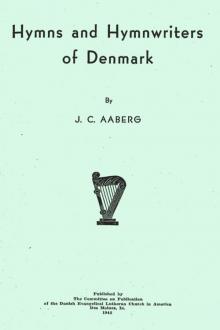Autobiography of Sir George Biddell Airy, George Biddell Airy [dark books to read TXT] 📗

- Author: George Biddell Airy
Book online «Autobiography of Sir George Biddell Airy, George Biddell Airy [dark books to read TXT] 📗». Author George Biddell Airy
a careful statement was inserted of the state in which it then stood. And, after his resignation of office, it formed the bulk of his occupation. In 1873 the Theory was formed, and by 1874 it was so far advanced that he published in the Monthly Notices of the Royal Astronomical Society a statement of the fundamental points of the Theory. In 1875, the Theory having advanced to a stage where extensive arithmetical computation was required, he obtained a small grant from the Government in aid of the expense of the work, and other grants were made in subsequent years. By 1878 the calculations were so far advanced that an opinion could be formed as to the probable accuracy of the Theory, and the following remark is made: "A cursory collation of the terms relating to the Areas (in the Ecliptic) led me to suppose that there might be some error in the computations of the Annual Equation and related terms;" but no error could be discovered and the work proceeded. The complex character of the Theory, and the extreme care required in the mathematical processes, are well illustrated by the following statement, which occurs in the Report of 1879, "An important error in the theoretical formulae for Variations of Radius Vector, Longitude, and Latitude, was discovered; some calculations depending on them are cancelled." In 1880 and 1881 the work was continued, but was "sadly interrupted by the pressure of the Transit of Venus work and other business." After his resignation of the Office of Astronomer Royal he had no further public assistance, and did much of the computations himself, but a sum of _L100_ was contributed by Mr De La Rue in furtherance of the work, and this sum was spent on computers. In his retirement the work made good progress, and on Dec. 31st, 1882, he made the following note: "I finished and put in general order the final tables of Equations of Variations. This is a definite point in the Lunar Theory.... I hope shortly to take up severely the numerical operations of the Lunar Theory from the very beginning." The work was continued steadily through 1883, and on Mar. 24th, 1884, he made application through the Board of Visitors to the Admiralty to print the work: after the usual enquiries as to the expense this was acceded to, and copy was sent to the printers as soon as it was ready. The first printed proofs were received on Feb. 5th, 1885, and the whole book was printed by the end of 1886. From the frequent references in his journal to errors discovered and corrected during the progress of these calculations, it would seem likely that his powers were not what they had been, and that there was a probability that some important errors might escape correction. He was far too honest to blind himself to this possibility, and in the Preface to his Numerical Lunar Theory he says thus: "I have explained above that the principle of operations was, to arrange the fundamental mechanical equations in a form suited for the investigations of Lunar Theory; to substitute in the terms of these equations the numerical values furnished by Delaunay's great work; and to examine whether the equations are thereby satisfied. With painful alarm, I find that they are not satisfied; and that the discordance, or failure of satisfying the equations, is large. The critical trial depends on the great mass of computations in Section II. These have been made in duplicate, with all the care for accuracy that anxiety could supply. Still I cannot but fear that the error which is the source of discordance must be on my part. I cannot conjecture whether I may be able to examine sufficiently into this matter." He resolutely took in hand the revision of his work, and continued it till October 1888. But it is clear from the entries in his journal that his powers were now unequal to the task, and although from time to time he suspected that he had discovered errors, yet it does not appear that he determined anything with certainty. He never doubted that there were important errors in the work, and later on he left the following private note on the subject:
NUMERICAL LUNAR THEORY.
_1890, Sept. 29_.
I had made considerable advance (under official difficulties) in calculations on my favourite Numerical Lunar Theory, when I discovered that, under the heavy pressure of unusual matters (two Transits of Venus and some eclipses) I had committed a grievous error in the first stage of giving numerical value to my Theory.
My spirit in the work was broken, and I have never heartily proceeded with it since.
G.B. AIRY.
Probably the error referred to here is the suspected error mentioned above in his Report of 1878, as to which he subsequently became more certain.
Whatever may be the imperfections of the Numerical Lunar Theory, it is a wonderful work to have been turned out by a man 85 years old. In its idea and inception it embodies the experience of a long life actively spent in practical science. And it may be that it will yet fulfil the objects of its author, and that some younger astronomer may take it up, correct its errors (wherever they may be), and fit it for practical use. And then the labour bestowed upon it will not have been in vain.
Subject always to the absorbing occupations of the Lunar Theory he amused himself with reading his favourite subjects of History and Antiquities. His movements during the remainder of the year 1881 were as follows: In September he paid a two days' visit to Lady Herschel at Hawkhurst. From Oct. 4th to 17th he was at the Cumberland Lakes and engaged in expeditions in the neighbourhood. From Nov. 5th to 8th he was at Cambridge, inspecting Prof. Stuart's workshops, and other scientific institutions. On Dec. 13th he went to Playford.--Amongst miscellaneous matters: in November he wrote to Mr Rothery on the loss of the 'Teuton' at some length, with suggestions for the safer construction of such vessels.--In October he was asked for suggestions regarding the establishment of a "Standard Time" applicable to the railway traffic in the United States: he replied as follows:
_1881, Oct. 31_.
SIR,
I have to acknowledge your letter of October 17, introducing to my notice the difficulty which appears to be arising in America regarding a "Standard Time," for extensive use throughout N. America "applicable to railway traffic only." The subject, as including considerations of convenience in all the matters to which it applies, is one of difficulties probably insuperable. The certainty, however, that objections may be raised to every scheme, renders me less timid in offering my own remarks; which are much at your service.
I first comment upon your expression of "Standard Time... applicable to railway traffic only." But do you mean this as affecting the transactions between one railway and another railway, or as affecting each railway and the local interests (temporal and others) of the towns which it touches? The difference is so great that I should be disposed to adopt it as marking very strongly the difference to be made between the practices of railways among themselves and the practices of railways towards the public; and will base a system on that difference.
As regards the practices of railways among themselves: if the various railways of America are joined and inosculated as they are in England, it appears to me indispensable that they have one common standard _among themselves_: say Washington Observatory time. But this is only needed for the office-transactions between the railways; it may be kept perfectly private; never communicated to the public at all. And I should recommend this as the first step.
There will then be no difficulty in deducing, from these private Washington times, the accurate local times at those stations (whose longitude is supposed to be fairly well known, as a sailor with a sextant can determine one in a few hours) which the railway authorities may deem worthy of that honour; generally the termini of railways. Thus we shall have a series of bases of local time, of authoritative character, through the country.
Of such bases _we_ have two, Greenwich and Dublin: and they are separated by a sea-voyage. In the U.S. of America there must be a greater number, and probably not so well separated. Still it is indispensable to adopt such a system of local centers.
No people in this world can be induced to use a reckoning which does not depend clearly upon the sun. In all civilized countries it depends (approximately) on the sun's meridian passage. Even the sailor on mid-ocean refers to that phenomenon. And the solar passage, with reasonable allowance, 20m. or 30m. one way or another, must be recognized in all time-arrangements as giving the fundamental time. The only practical way of doing this is, to adopt for a whole region the fundamental time of a center of that region.
And to this fundamental time, the local time of the railway, as now entering into all the concerns of life, must be adapted. A solicitor has an appointment to meet a client by railway; a physician to a consultation. How is this to be kept if the railway uses one time and every other act of life another?
There is one chain of circumstances which is almost peculiar--that of the line from New York to San Francisco. Here I would have two clocks at every station: those on the north side all shewing San Francisco time, and those on the south all shewing New York time. Every traveller's watch would then be available to the end of his journey.
A system, fundamentally such as I have sketched, would give little trouble, and may I think be adopted with advantage.
I am, Sir,
Your faithful servant,
G.B. AIRY.
_Mr Edward Barrington._
1882
He returned from Playford on Jan. 17: his other movements during the year were as follows: from Apr. 27th to May 11th he was at Playford; and again from August 1st to 24th. From Oct. 9th to Nov. 1st he was travelling with his two unmarried daughters in the Lake District of Cumberland: the journey was by Furness and Coniston to Portinscale near Keswick; on Oct. 13th he fell and sprained
NUMERICAL LUNAR THEORY.
_1890, Sept. 29_.
I had made considerable advance (under official difficulties) in calculations on my favourite Numerical Lunar Theory, when I discovered that, under the heavy pressure of unusual matters (two Transits of Venus and some eclipses) I had committed a grievous error in the first stage of giving numerical value to my Theory.
My spirit in the work was broken, and I have never heartily proceeded with it since.
G.B. AIRY.
Probably the error referred to here is the suspected error mentioned above in his Report of 1878, as to which he subsequently became more certain.
Whatever may be the imperfections of the Numerical Lunar Theory, it is a wonderful work to have been turned out by a man 85 years old. In its idea and inception it embodies the experience of a long life actively spent in practical science. And it may be that it will yet fulfil the objects of its author, and that some younger astronomer may take it up, correct its errors (wherever they may be), and fit it for practical use. And then the labour bestowed upon it will not have been in vain.
Subject always to the absorbing occupations of the Lunar Theory he amused himself with reading his favourite subjects of History and Antiquities. His movements during the remainder of the year 1881 were as follows: In September he paid a two days' visit to Lady Herschel at Hawkhurst. From Oct. 4th to 17th he was at the Cumberland Lakes and engaged in expeditions in the neighbourhood. From Nov. 5th to 8th he was at Cambridge, inspecting Prof. Stuart's workshops, and other scientific institutions. On Dec. 13th he went to Playford.--Amongst miscellaneous matters: in November he wrote to Mr Rothery on the loss of the 'Teuton' at some length, with suggestions for the safer construction of such vessels.--In October he was asked for suggestions regarding the establishment of a "Standard Time" applicable to the railway traffic in the United States: he replied as follows:
_1881, Oct. 31_.
SIR,
I have to acknowledge your letter of October 17, introducing to my notice the difficulty which appears to be arising in America regarding a "Standard Time," for extensive use throughout N. America "applicable to railway traffic only." The subject, as including considerations of convenience in all the matters to which it applies, is one of difficulties probably insuperable. The certainty, however, that objections may be raised to every scheme, renders me less timid in offering my own remarks; which are much at your service.
I first comment upon your expression of "Standard Time... applicable to railway traffic only." But do you mean this as affecting the transactions between one railway and another railway, or as affecting each railway and the local interests (temporal and others) of the towns which it touches? The difference is so great that I should be disposed to adopt it as marking very strongly the difference to be made between the practices of railways among themselves and the practices of railways towards the public; and will base a system on that difference.
As regards the practices of railways among themselves: if the various railways of America are joined and inosculated as they are in England, it appears to me indispensable that they have one common standard _among themselves_: say Washington Observatory time. But this is only needed for the office-transactions between the railways; it may be kept perfectly private; never communicated to the public at all. And I should recommend this as the first step.
There will then be no difficulty in deducing, from these private Washington times, the accurate local times at those stations (whose longitude is supposed to be fairly well known, as a sailor with a sextant can determine one in a few hours) which the railway authorities may deem worthy of that honour; generally the termini of railways. Thus we shall have a series of bases of local time, of authoritative character, through the country.
Of such bases _we_ have two, Greenwich and Dublin: and they are separated by a sea-voyage. In the U.S. of America there must be a greater number, and probably not so well separated. Still it is indispensable to adopt such a system of local centers.
No people in this world can be induced to use a reckoning which does not depend clearly upon the sun. In all civilized countries it depends (approximately) on the sun's meridian passage. Even the sailor on mid-ocean refers to that phenomenon. And the solar passage, with reasonable allowance, 20m. or 30m. one way or another, must be recognized in all time-arrangements as giving the fundamental time. The only practical way of doing this is, to adopt for a whole region the fundamental time of a center of that region.
And to this fundamental time, the local time of the railway, as now entering into all the concerns of life, must be adapted. A solicitor has an appointment to meet a client by railway; a physician to a consultation. How is this to be kept if the railway uses one time and every other act of life another?
There is one chain of circumstances which is almost peculiar--that of the line from New York to San Francisco. Here I would have two clocks at every station: those on the north side all shewing San Francisco time, and those on the south all shewing New York time. Every traveller's watch would then be available to the end of his journey.
A system, fundamentally such as I have sketched, would give little trouble, and may I think be adopted with advantage.
I am, Sir,
Your faithful servant,
G.B. AIRY.
_Mr Edward Barrington._
1882
He returned from Playford on Jan. 17: his other movements during the year were as follows: from Apr. 27th to May 11th he was at Playford; and again from August 1st to 24th. From Oct. 9th to Nov. 1st he was travelling with his two unmarried daughters in the Lake District of Cumberland: the journey was by Furness and Coniston to Portinscale near Keswick; on Oct. 13th he fell and sprained
Free e-book «Autobiography of Sir George Biddell Airy, George Biddell Airy [dark books to read TXT] 📗» - read online now
Similar e-books:





Comments (0)